Cultural Dimension: Impact on Business and Global Manufacturing Essay
VerifiedAdded on 2021/04/17
|6
|1820
|131
Essay
AI Summary
This essay delves into the critical role of cultural dimensions in shaping business practices and strategies, with a particular focus on the impact of culture on global manufacturing. It begins by defining culture and its significance in influencing social behaviors, norms, and values within a society. The essay then explores various cultural theories, including Marxism, feminism, and Hofstede's cultural dimension theory, highlighting their relevance in understanding the behaviors and responses of individuals within international organizations. The essay uses the example of China's manufacturing sector and its growing appeal to global manufacturers, discussing the country's cultural characteristics, such as its hardworking population and hierarchical structure, as described by Hofstede's theory. The essay also provides a personal reflection from an Australian perspective, contrasting Australian business culture with that of China, emphasizing the importance of direct communication, time management, and professional ethics. The conclusion underscores the need for businesses to understand and adapt to different cultural dimensions to succeed in a globalized marketplace.
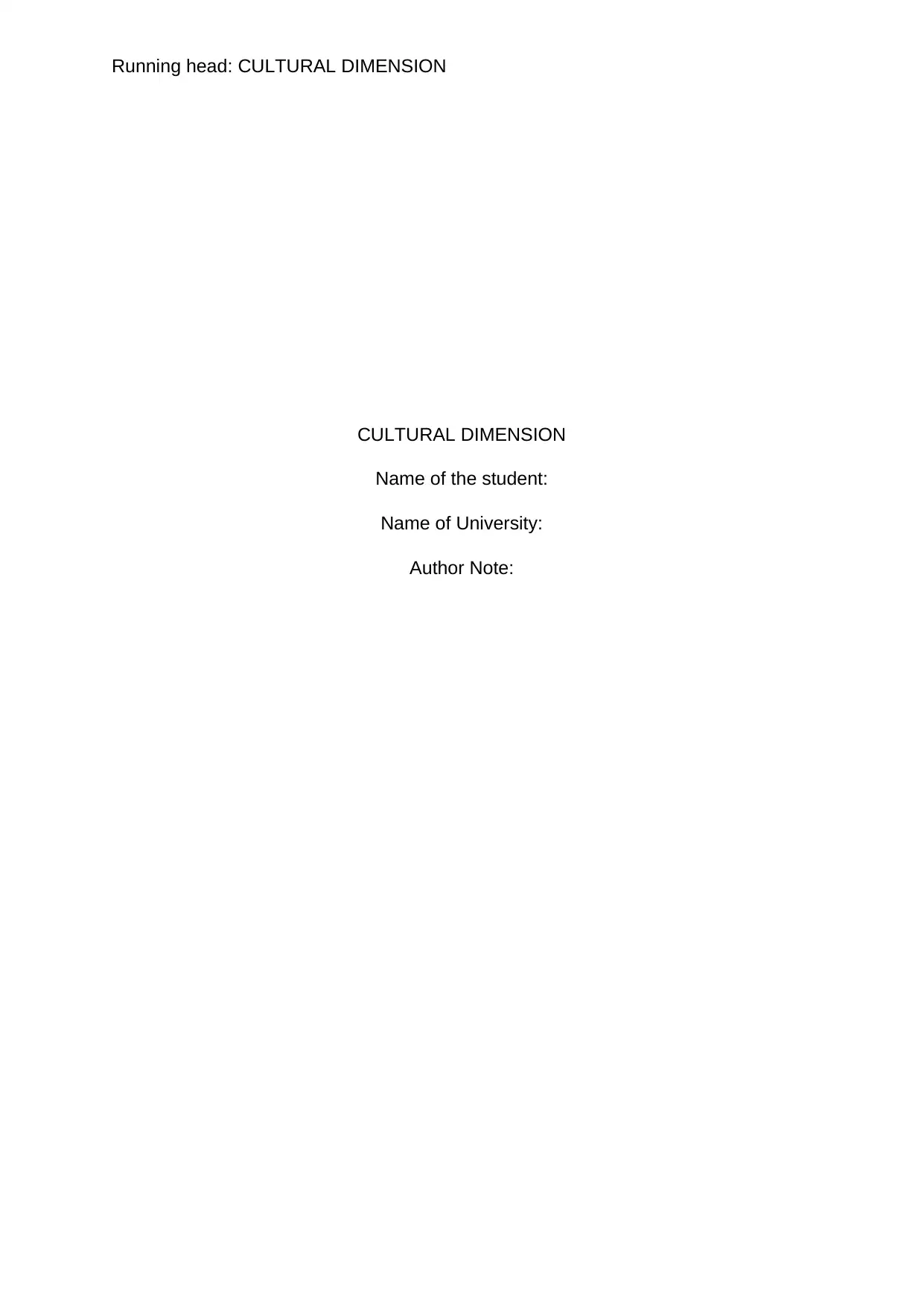
Running head: CULTURAL DIMENSION
CULTURAL DIMENSION
Name of the student:
Name of University:
Author Note:
CULTURAL DIMENSION
Name of the student:
Name of University:
Author Note:
Paraphrase This Document
Need a fresh take? Get an instant paraphrase of this document with our AI Paraphraser
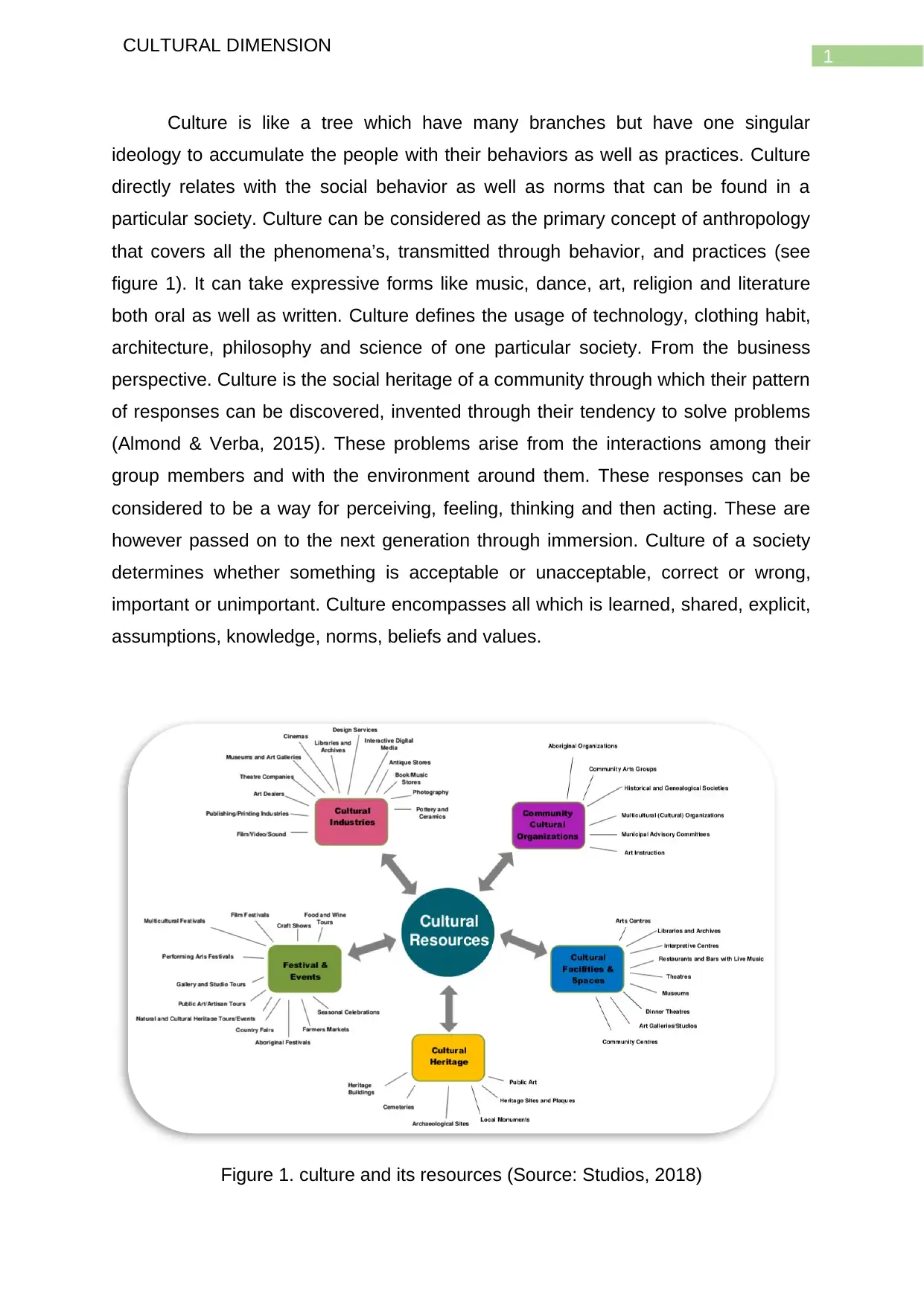
1
CULTURAL DIMENSION
Culture is like a tree which have many branches but have one singular
ideology to accumulate the people with their behaviors as well as practices. Culture
directly relates with the social behavior as well as norms that can be found in a
particular society. Culture can be considered as the primary concept of anthropology
that covers all the phenomena’s, transmitted through behavior, and practices (see
figure 1). It can take expressive forms like music, dance, art, religion and literature
both oral as well as written. Culture defines the usage of technology, clothing habit,
architecture, philosophy and science of one particular society. From the business
perspective. Culture is the social heritage of a community through which their pattern
of responses can be discovered, invented through their tendency to solve problems
(Almond & Verba, 2015). These problems arise from the interactions among their
group members and with the environment around them. These responses can be
considered to be a way for perceiving, feeling, thinking and then acting. These are
however passed on to the next generation through immersion. Culture of a society
determines whether something is acceptable or unacceptable, correct or wrong,
important or unimportant. Culture encompasses all which is learned, shared, explicit,
assumptions, knowledge, norms, beliefs and values.
Figure 1. culture and its resources (Source: Studios, 2018)
CULTURAL DIMENSION
Culture is like a tree which have many branches but have one singular
ideology to accumulate the people with their behaviors as well as practices. Culture
directly relates with the social behavior as well as norms that can be found in a
particular society. Culture can be considered as the primary concept of anthropology
that covers all the phenomena’s, transmitted through behavior, and practices (see
figure 1). It can take expressive forms like music, dance, art, religion and literature
both oral as well as written. Culture defines the usage of technology, clothing habit,
architecture, philosophy and science of one particular society. From the business
perspective. Culture is the social heritage of a community through which their pattern
of responses can be discovered, invented through their tendency to solve problems
(Almond & Verba, 2015). These problems arise from the interactions among their
group members and with the environment around them. These responses can be
considered to be a way for perceiving, feeling, thinking and then acting. These are
however passed on to the next generation through immersion. Culture of a society
determines whether something is acceptable or unacceptable, correct or wrong,
important or unimportant. Culture encompasses all which is learned, shared, explicit,
assumptions, knowledge, norms, beliefs and values.
Figure 1. culture and its resources (Source: Studios, 2018)

2
CULTURAL DIMENSION
The cultural studies concentrate on the political dynamics of the contemporary
culture where the historical foundations along with conflicts, traits and contingencies.
Different ideologies, national information, class structure, ethnicity, gender and
generation are the various factors that determine the role of the culture in the real
world. There are various theories that focus upon the cultural aspects, demonstrated
by different countries (Lane & Maznevski, 2014). The cultural theories such as
Marxism, feminism, cultural race theory, colonialism, cultural dimension theory, post
structuralism focus on the ethnography of the people around the world. These reveal
the attitude, behaviors, preferences and responses of the group members among
them as well as their interactions with the environment. All of these cultural theories
emphasis upon the impact of the culture on the behaviors and responses of people
associated with international organizations. Though these theories, one can define
the causes of various cultural issues such as racism, inequality, discrimination in the
global organizations.
As the article, ‘Manufacturing in China Can Give Your Business the
Competitive Advantage’ by Michael Evans and Jack Toolan has discussed, the
global manufacturers are recording a growing preference to the Chinese culture for
increasing their business (Forbes.com, 2018). According to the colonialist theory the
Republic of China was considered to be the market previously. Before 20 years, the
when it opened its market with 1.3 billion consumers, the global manufacturers
though it to be a great opportunity to explore and gain profit. However, China’s
outsourcing market recently have grown 30 percent each year. This is the reason
why many of the countries have been relocating their headquarters in china. The
innovativeness and production capacity of the employees of the country has enabled
them to create a scope for higher volume of product. For this, the manufacturers do
not need to invest high amount of cost. The organizational culture of the country
needs a little research as well as sourcing hence the companies can build
partnership with the chines organizations in order to manufacture the latest product
invention (Helmreich & Merritt, 2017). However, the organizational culture does not
allow any kind of shortcut to success as the country makes possible anything but not
easily.
According to the cultural dimension theory proposed by Hofstede, the people
of China are very hardworking and do not prefer to indulge in leisure at the time of
CULTURAL DIMENSION
The cultural studies concentrate on the political dynamics of the contemporary
culture where the historical foundations along with conflicts, traits and contingencies.
Different ideologies, national information, class structure, ethnicity, gender and
generation are the various factors that determine the role of the culture in the real
world. There are various theories that focus upon the cultural aspects, demonstrated
by different countries (Lane & Maznevski, 2014). The cultural theories such as
Marxism, feminism, cultural race theory, colonialism, cultural dimension theory, post
structuralism focus on the ethnography of the people around the world. These reveal
the attitude, behaviors, preferences and responses of the group members among
them as well as their interactions with the environment. All of these cultural theories
emphasis upon the impact of the culture on the behaviors and responses of people
associated with international organizations. Though these theories, one can define
the causes of various cultural issues such as racism, inequality, discrimination in the
global organizations.
As the article, ‘Manufacturing in China Can Give Your Business the
Competitive Advantage’ by Michael Evans and Jack Toolan has discussed, the
global manufacturers are recording a growing preference to the Chinese culture for
increasing their business (Forbes.com, 2018). According to the colonialist theory the
Republic of China was considered to be the market previously. Before 20 years, the
when it opened its market with 1.3 billion consumers, the global manufacturers
though it to be a great opportunity to explore and gain profit. However, China’s
outsourcing market recently have grown 30 percent each year. This is the reason
why many of the countries have been relocating their headquarters in china. The
innovativeness and production capacity of the employees of the country has enabled
them to create a scope for higher volume of product. For this, the manufacturers do
not need to invest high amount of cost. The organizational culture of the country
needs a little research as well as sourcing hence the companies can build
partnership with the chines organizations in order to manufacture the latest product
invention (Helmreich & Merritt, 2017). However, the organizational culture does not
allow any kind of shortcut to success as the country makes possible anything but not
easily.
According to the cultural dimension theory proposed by Hofstede, the people
of China are very hardworking and do not prefer to indulge in leisure at the time of
⊘ This is a preview!⊘
Do you want full access?
Subscribe today to unlock all pages.

Trusted by 1+ million students worldwide
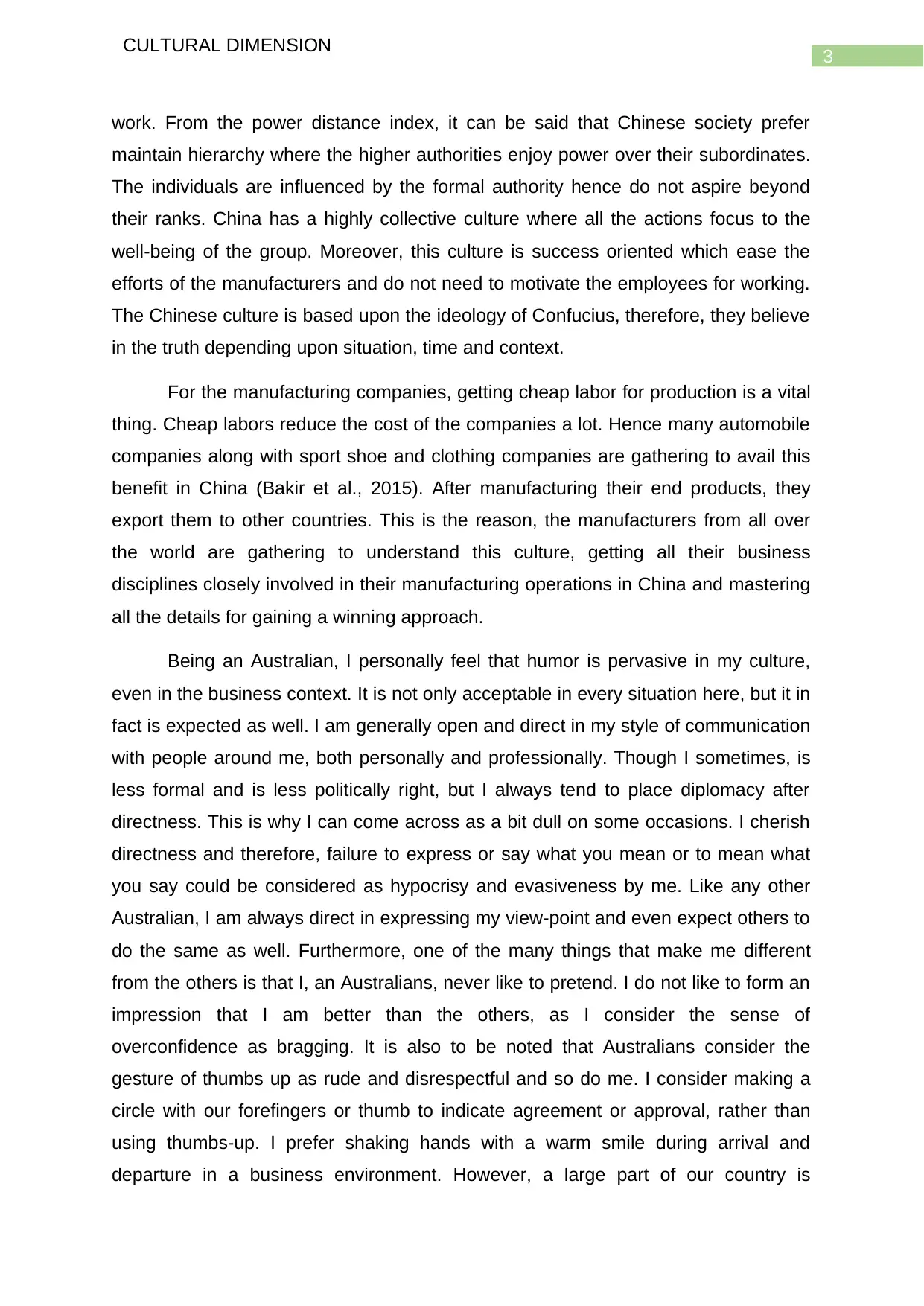
3
CULTURAL DIMENSION
work. From the power distance index, it can be said that Chinese society prefer
maintain hierarchy where the higher authorities enjoy power over their subordinates.
The individuals are influenced by the formal authority hence do not aspire beyond
their ranks. China has a highly collective culture where all the actions focus to the
well-being of the group. Moreover, this culture is success oriented which ease the
efforts of the manufacturers and do not need to motivate the employees for working.
The Chinese culture is based upon the ideology of Confucius, therefore, they believe
in the truth depending upon situation, time and context.
For the manufacturing companies, getting cheap labor for production is a vital
thing. Cheap labors reduce the cost of the companies a lot. Hence many automobile
companies along with sport shoe and clothing companies are gathering to avail this
benefit in China (Bakir et al., 2015). After manufacturing their end products, they
export them to other countries. This is the reason, the manufacturers from all over
the world are gathering to understand this culture, getting all their business
disciplines closely involved in their manufacturing operations in China and mastering
all the details for gaining a winning approach.
Being an Australian, I personally feel that humor is pervasive in my culture,
even in the business context. It is not only acceptable in every situation here, but it in
fact is expected as well. I am generally open and direct in my style of communication
with people around me, both personally and professionally. Though I sometimes, is
less formal and is less politically right, but I always tend to place diplomacy after
directness. This is why I can come across as a bit dull on some occasions. I cherish
directness and therefore, failure to express or say what you mean or to mean what
you say could be considered as hypocrisy and evasiveness by me. Like any other
Australian, I am always direct in expressing my view-point and even expect others to
do the same as well. Furthermore, one of the many things that make me different
from the others is that I, an Australians, never like to pretend. I do not like to form an
impression that I am better than the others, as I consider the sense of
overconfidence as bragging. It is also to be noted that Australians consider the
gesture of thumbs up as rude and disrespectful and so do me. I consider making a
circle with our forefingers or thumb to indicate agreement or approval, rather than
using thumbs-up. I prefer shaking hands with a warm smile during arrival and
departure in a business environment. However, a large part of our country is
CULTURAL DIMENSION
work. From the power distance index, it can be said that Chinese society prefer
maintain hierarchy where the higher authorities enjoy power over their subordinates.
The individuals are influenced by the formal authority hence do not aspire beyond
their ranks. China has a highly collective culture where all the actions focus to the
well-being of the group. Moreover, this culture is success oriented which ease the
efforts of the manufacturers and do not need to motivate the employees for working.
The Chinese culture is based upon the ideology of Confucius, therefore, they believe
in the truth depending upon situation, time and context.
For the manufacturing companies, getting cheap labor for production is a vital
thing. Cheap labors reduce the cost of the companies a lot. Hence many automobile
companies along with sport shoe and clothing companies are gathering to avail this
benefit in China (Bakir et al., 2015). After manufacturing their end products, they
export them to other countries. This is the reason, the manufacturers from all over
the world are gathering to understand this culture, getting all their business
disciplines closely involved in their manufacturing operations in China and mastering
all the details for gaining a winning approach.
Being an Australian, I personally feel that humor is pervasive in my culture,
even in the business context. It is not only acceptable in every situation here, but it in
fact is expected as well. I am generally open and direct in my style of communication
with people around me, both personally and professionally. Though I sometimes, is
less formal and is less politically right, but I always tend to place diplomacy after
directness. This is why I can come across as a bit dull on some occasions. I cherish
directness and therefore, failure to express or say what you mean or to mean what
you say could be considered as hypocrisy and evasiveness by me. Like any other
Australian, I am always direct in expressing my view-point and even expect others to
do the same as well. Furthermore, one of the many things that make me different
from the others is that I, an Australians, never like to pretend. I do not like to form an
impression that I am better than the others, as I consider the sense of
overconfidence as bragging. It is also to be noted that Australians consider the
gesture of thumbs up as rude and disrespectful and so do me. I consider making a
circle with our forefingers or thumb to indicate agreement or approval, rather than
using thumbs-up. I prefer shaking hands with a warm smile during arrival and
departure in a business environment. However, a large part of our country is
Paraphrase This Document
Need a fresh take? Get an instant paraphrase of this document with our AI Paraphraser
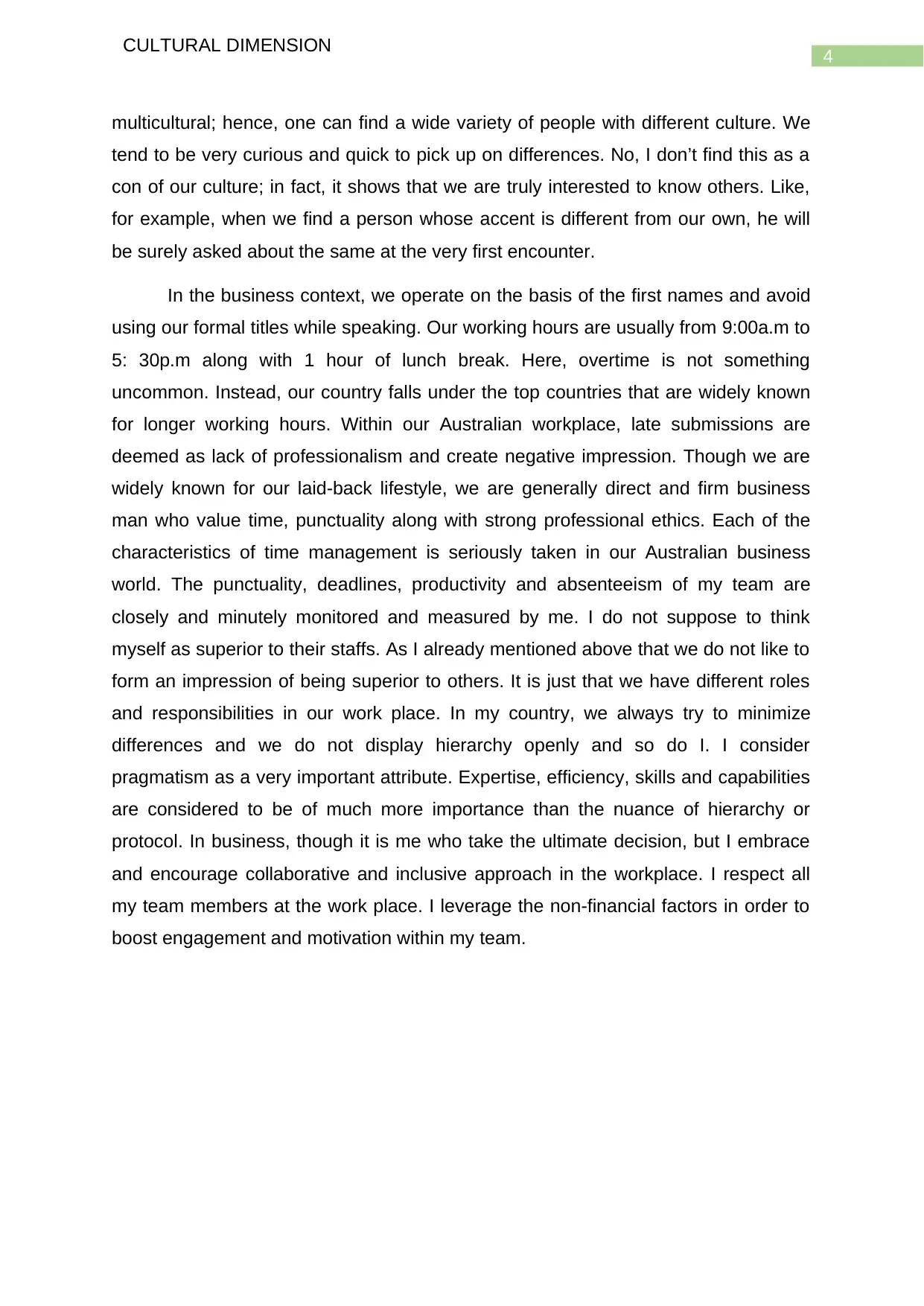
4
CULTURAL DIMENSION
multicultural; hence, one can find a wide variety of people with different culture. We
tend to be very curious and quick to pick up on differences. No, I don’t find this as a
con of our culture; in fact, it shows that we are truly interested to know others. Like,
for example, when we find a person whose accent is different from our own, he will
be surely asked about the same at the very first encounter.
In the business context, we operate on the basis of the first names and avoid
using our formal titles while speaking. Our working hours are usually from 9:00a.m to
5: 30p.m along with 1 hour of lunch break. Here, overtime is not something
uncommon. Instead, our country falls under the top countries that are widely known
for longer working hours. Within our Australian workplace, late submissions are
deemed as lack of professionalism and create negative impression. Though we are
widely known for our laid-back lifestyle, we are generally direct and firm business
man who value time, punctuality along with strong professional ethics. Each of the
characteristics of time management is seriously taken in our Australian business
world. The punctuality, deadlines, productivity and absenteeism of my team are
closely and minutely monitored and measured by me. I do not suppose to think
myself as superior to their staffs. As I already mentioned above that we do not like to
form an impression of being superior to others. It is just that we have different roles
and responsibilities in our work place. In my country, we always try to minimize
differences and we do not display hierarchy openly and so do I. I consider
pragmatism as a very important attribute. Expertise, efficiency, skills and capabilities
are considered to be of much more importance than the nuance of hierarchy or
protocol. In business, though it is me who take the ultimate decision, but I embrace
and encourage collaborative and inclusive approach in the workplace. I respect all
my team members at the work place. I leverage the non-financial factors in order to
boost engagement and motivation within my team.
CULTURAL DIMENSION
multicultural; hence, one can find a wide variety of people with different culture. We
tend to be very curious and quick to pick up on differences. No, I don’t find this as a
con of our culture; in fact, it shows that we are truly interested to know others. Like,
for example, when we find a person whose accent is different from our own, he will
be surely asked about the same at the very first encounter.
In the business context, we operate on the basis of the first names and avoid
using our formal titles while speaking. Our working hours are usually from 9:00a.m to
5: 30p.m along with 1 hour of lunch break. Here, overtime is not something
uncommon. Instead, our country falls under the top countries that are widely known
for longer working hours. Within our Australian workplace, late submissions are
deemed as lack of professionalism and create negative impression. Though we are
widely known for our laid-back lifestyle, we are generally direct and firm business
man who value time, punctuality along with strong professional ethics. Each of the
characteristics of time management is seriously taken in our Australian business
world. The punctuality, deadlines, productivity and absenteeism of my team are
closely and minutely monitored and measured by me. I do not suppose to think
myself as superior to their staffs. As I already mentioned above that we do not like to
form an impression of being superior to others. It is just that we have different roles
and responsibilities in our work place. In my country, we always try to minimize
differences and we do not display hierarchy openly and so do I. I consider
pragmatism as a very important attribute. Expertise, efficiency, skills and capabilities
are considered to be of much more importance than the nuance of hierarchy or
protocol. In business, though it is me who take the ultimate decision, but I embrace
and encourage collaborative and inclusive approach in the workplace. I respect all
my team members at the work place. I leverage the non-financial factors in order to
boost engagement and motivation within my team.
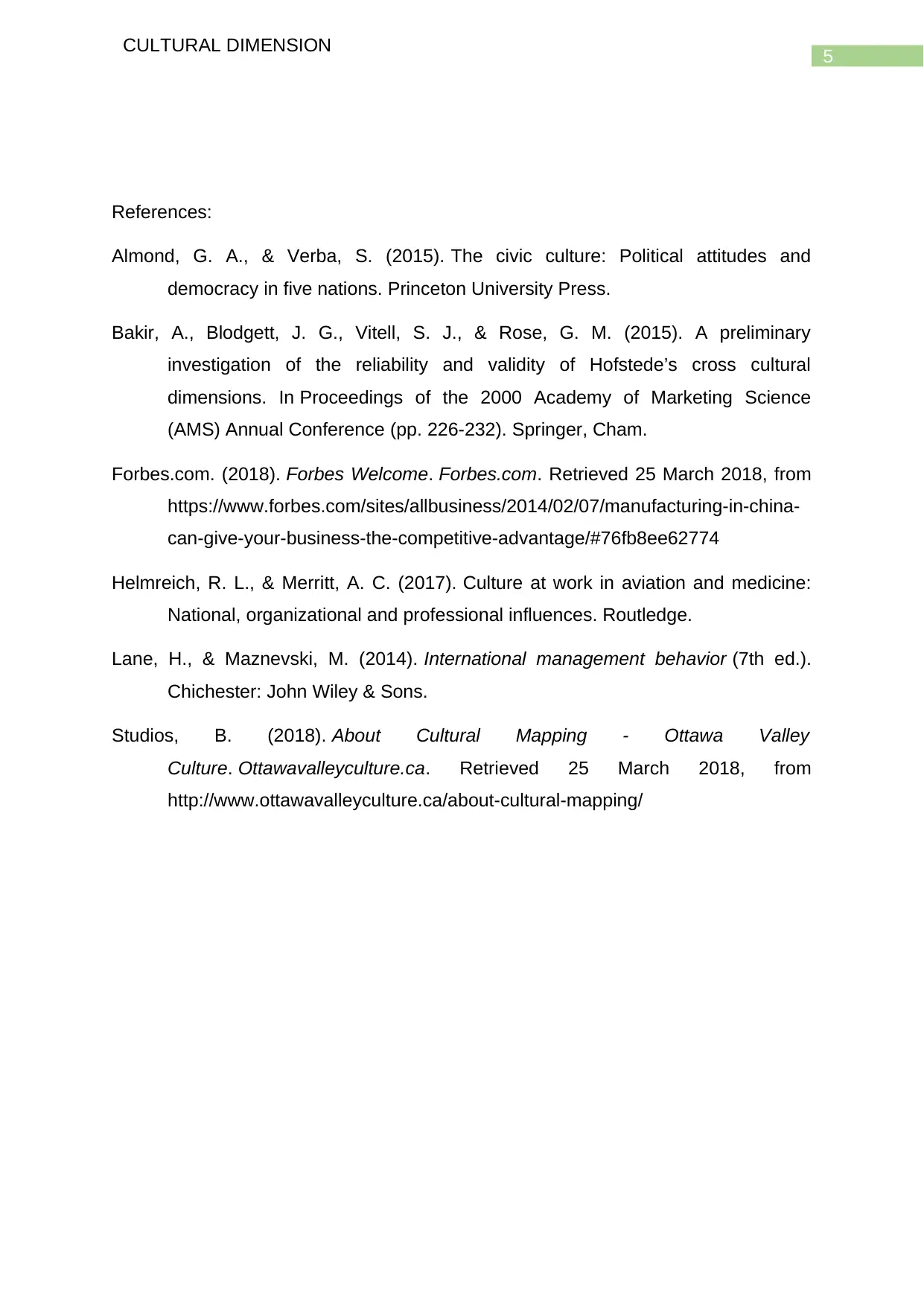
5
CULTURAL DIMENSION
References:
Almond, G. A., & Verba, S. (2015). The civic culture: Political attitudes and
democracy in five nations. Princeton University Press.
Bakir, A., Blodgett, J. G., Vitell, S. J., & Rose, G. M. (2015). A preliminary
investigation of the reliability and validity of Hofstede’s cross cultural
dimensions. In Proceedings of the 2000 Academy of Marketing Science
(AMS) Annual Conference (pp. 226-232). Springer, Cham.
Forbes.com. (2018). Forbes Welcome. Forbes.com. Retrieved 25 March 2018, from
https://www.forbes.com/sites/allbusiness/2014/02/07/manufacturing-in-china-
can-give-your-business-the-competitive-advantage/#76fb8ee62774
Helmreich, R. L., & Merritt, A. C. (2017). Culture at work in aviation and medicine:
National, organizational and professional influences. Routledge.
Lane, H., & Maznevski, M. (2014). International management behavior (7th ed.).
Chichester: John Wiley & Sons.
Studios, B. (2018). About Cultural Mapping - Ottawa Valley
Culture. Ottawavalleyculture.ca. Retrieved 25 March 2018, from
http://www.ottawavalleyculture.ca/about-cultural-mapping/
CULTURAL DIMENSION
References:
Almond, G. A., & Verba, S. (2015). The civic culture: Political attitudes and
democracy in five nations. Princeton University Press.
Bakir, A., Blodgett, J. G., Vitell, S. J., & Rose, G. M. (2015). A preliminary
investigation of the reliability and validity of Hofstede’s cross cultural
dimensions. In Proceedings of the 2000 Academy of Marketing Science
(AMS) Annual Conference (pp. 226-232). Springer, Cham.
Forbes.com. (2018). Forbes Welcome. Forbes.com. Retrieved 25 March 2018, from
https://www.forbes.com/sites/allbusiness/2014/02/07/manufacturing-in-china-
can-give-your-business-the-competitive-advantage/#76fb8ee62774
Helmreich, R. L., & Merritt, A. C. (2017). Culture at work in aviation and medicine:
National, organizational and professional influences. Routledge.
Lane, H., & Maznevski, M. (2014). International management behavior (7th ed.).
Chichester: John Wiley & Sons.
Studios, B. (2018). About Cultural Mapping - Ottawa Valley
Culture. Ottawavalleyculture.ca. Retrieved 25 March 2018, from
http://www.ottawavalleyculture.ca/about-cultural-mapping/
⊘ This is a preview!⊘
Do you want full access?
Subscribe today to unlock all pages.

Trusted by 1+ million students worldwide
1 out of 6
Related Documents
Your All-in-One AI-Powered Toolkit for Academic Success.
+13062052269
info@desklib.com
Available 24*7 on WhatsApp / Email
![[object Object]](/_next/static/media/star-bottom.7253800d.svg)
Unlock your academic potential
Copyright © 2020–2025 A2Z Services. All Rights Reserved. Developed and managed by ZUCOL.




